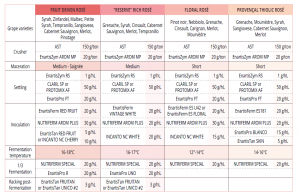Enartis News – Time for rosé
Rosé wines are defined by their pink colour, simplicity, elegance and freshness. Whatever your style, some steps in rosé wine production are critical and require the adoption of specific technical measures.
PRE-FERMENTATION PHASE
Protection against Oxidation
- Enzymatic oxidation of juice happens quickly and causes browning, production of vegetal notes and loss of varietal aromas. Every effort to minimize oxidation will be rewarded with a better-quality wine.
- Work at cold temperatures during all prefermentation steps to slow oxidative reactions.
- Reduce oxygen contact by working fast, under inert gas or using antioxidant agents.
Harvest and Transport
- Start planning for making rosé wines in the vineyard and base picking decisions on the balance between acidity and sugar. Healthy fruit and early acid adjustment are highly recommended.
- Harvest overnight or early in the morning for cool grapes. Avoid long transport times and maceration in transport bins.
- In case of juice formation during harvesting and transport, spread AST on the bottom of the bin for antimicrobial and antioxidant protection of the juice.
Destemming, Pressing and Maceration
- Destem to avoid extracting herbaceous aromas and green tannins.
- Based on the rosé style that you like, press grapes directly or do preferred maceration, knowing that duration and temperature of maceration impact
wine quality as follows:
– Cold: lighter colour, bigger expression of fermentation aromas, higher acidity, lower pH.
– Warm: more intense colour, bigger extraction of varietal aromas, lower acidity, higher pH.
– Long: more intense colour, more roundness, more sugars, lower acidity, higher pH.
- In the press, a maceration enzyme such as EnartisZym AROM MP improves colour and protein stability, polysaccharide and aroma extraction, and increases free run yield.
Settling
- Aim for juice turbidity between 80 and 200 NTU for optimal yeast performance during fermentation. This will favor the production of a high quality rosè wine. Higher turbidity increases herbaceous aromas and reduces olfactory cleanliness and softness.
- Use EnartisZym RS, a rapid pectolytic enzyme, to speed up the settling process.
- If necessary, do fining and colour corrective treatments:
– PROTOMIX AF or Claril SP removes oxidation precursors, oxidized molecules and off-aromas.
– COMBISTAB AF to remove oxidation precursors, once wine is protein stable.
– EnartisPro FT removes heavy metals that catalyse oxidation reactions and improves wine antioxidant protection and ageing potential.
FERMENTATION PHASE
The synthesis and release of aromas happens during fermentation. Wine style depends on grape aromatic compounds, yeast, yeast nutrition and fermentation
temperature.

Yeast
- EnartisFerm RED FRUIT increases varietal aromas expression and promotes the production of red fruit, red berries, forest fruits and helps colour stability.
- EnartisFerm VINTAGE WHITE reveals the varietal aroma and produces a creamy palate.
- EnartisFerm ES FLORAL produces elegant wines with intense floral aromas such as white rose, citrus blossom and fruity notes as pear and green apple.
- EnartisFerm ES U42 produces intense aroma of rose and very full, round and soft palate.
- EnartisFerm ES181 reveals thiols, increases aroma complexity, and produces fresh and pleasant wines.
Yeast nutrition
- NUTRIFERM X: unique yeast nutrient developed on the latest research in the synthesis of thiols, its application increases thiol expression. Speak to your local sales representative for more information.
- NUTRIFERM AROM PLUS: autolyzed yeast-based nutrient, provides the branched chain amino acids that yeast can use to produce esters and other aromatically active compounds.
- NUTRIFERM SPECIAL: at 1/3 alcoholic fermentation, improves yeast activity, detoxifies wine and reduces production of H2S.
Fermentation temperature
- Cold (12-14°C): longer fermentation, more secondary aromas, lower total acidity.
- Warm (18-20°C): increase thiol and varietal aroma expression.
Tannins, oak alternatives, and yeast polysaccharides
- EnartisTan RF: blend of condensed tannins extracted from exotic wood species, helps colour stability and the expression of red fruit notes.
- EnartisTan CIT: blend of gallic and condensed tannins extracted from exotic wood species, protects from oxidation and enhances wine freshness, slowing down the wine ageing process.
- EnartisTan SKIN: tannin extracted from the skin of unfermented white grapes, it enhances thiol expression.
- INCANTO NC WHITE: blend of oak, acacia tannins and yeast derivatives that increases the flavour of fresh fruit and enhances softness and volume.
- INCANTO NC CHERRY: blend of tannin and yeast derivative that promotes color stabilization and enhances fresh red fruit notes.
- EnartisPro BLANCO: inactivated yeast rich in free mannoproteins and sulfur amino acids that produces rosés with young, intense and fresh color and helps thiol expression.

POST-FERMENTATION: PRESERVATION OF WINE QUALITY
Maturation, Stabilization and Bottling
Oxygen is the primary enemy of rosé wines. At racking and during cellar operations, protect wine with inert gas, maintain a high content of dissolved CO2 and a temperature of around 13-14°C. The addition of EnartisStab SLI helps to maintain a low redox potential and consequently preserves greater aromatic and colour freshness. Also, tannins like EnartisTan Fruitan and EnartisTan Unico #2 help to maintain an attractive fresh and fruity profile while protecting colour and aroma form oxidation. At settling, clarification and filtration, the addition of EnartisTan SLI, helps consume dissolved oxygen while respecting wine organoleptic features and increases freshness. At bottling, Citrostab rH performs the same function. For tartaric stabilization of wine, the use of Zenith Uno as an alternative to cold stabilization minimizes the risk of oxidation.